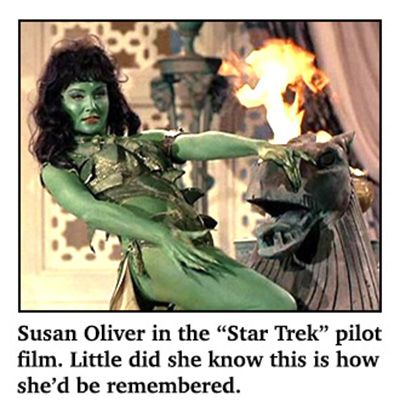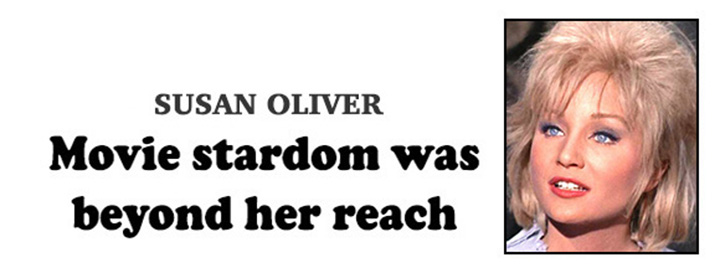It was in 2018, while watching a documentary called "The Green Girl," that I remembered a phone interview from my distant past — 55 years to be exact — with the subject of that documentary, actress Susan Oliver.
Reason for the documentary was an Oliver performance in the 1966 pilot film for the original "Star Trek" series. The pilot film, which wasn't shown on television until 1986, starred Jeffrey Hunter in the role that would be played in the 1966 series by William Shatner. Susan Oliver was cast as a green alien who did a dance that — at the time — was considered sexy, though today it's almost as funny as the herky-jerky Elaine Benes (Julia Louis-Dreyfuss) movements in a well-remembered episode of "Seinfeld."
Because "Star Trek" attracted such a cult following over the years. this pilot film, and Miss Oliver's strange, green appearance have taken on more importance, if you will, than more entertaining first episodes of dozens of other series. It also wasn't the first time the color green was significant in Miss Oliver's career, since her first starring role in a movie was as the title character in 1957's "The Green-Eyed Blonde."
The documentary, written and directed by George A. Pappy Jr., obviously a big "Star Trek" fan, is intended as a tribute to an interesting actress who never quite lived up to expectations.
WHEN I TALKED to her on the telephone, in October, 1963, it was in connection with her guest spot on a two-part episode of "The Fugitive," then one of the most popular TV series. Three years earlier she seemed poised for a movie career when she garnered good reviews for a supporting role in "BUtterfield 8," a rather silly melodrama that somehow earned an Academy Award for Elizabeth Taylor, who played a prostitute.
Taylor thus reinforced her reputation as one of the world's most popular movie stars,, while 24-year-old Susan Oliver slipped back into her pre-"BUtterfield 8" routine of guest starring in just about every television series except "Wild World of Sports."
That this was a sore point with Miss Oliver was clear during our interview. She blamed her situation on her talent agency, which, she said, was too large.
“I got lost in the crowd,” she said. “The agency simply forgot about me. Actually, it was as much my fault as it was theirs. Steve McQueen would have stormed into the agency and shouted, ‘Look, either you find work for me or I’ll bust up your office.’ And he would have gotten results. That’s what I should have done.”
MOVIE PRODUCERS didn't have Susan Oliver on their radar,but she was much in demand for television series, and appeared in everything from "The Adventures of Ozzie and Harriet" to "Twilight Zone," "Playhouse 90," "Naked City," "Wagon Train," and "Route 66."
There were several other actors — men and women — in a similar position. That is, they'd be offered an occasional movie role, but they were seen most often on prime time television. Only a handful of actors were working exclusively in theatrical movies — Paul Newman, Audrey Hepburn, Gregory Peck, and Jack Lemmon come to mind — but most of them eventually would be featured in a television movie or two.
Miss Oliver mentioned during our interview that she had recently signed a contract that guaranteed her at least one movie a year for the next five years. Earlier in the year she appeared in her first film since "BUtterfield 8." That film was "The Caretakers," about a mental institution, and her name was buried deep in the cast list behind Robert Stack, Polly Bergen, Joan Crawford, and three young actresses who were primarily known for work on television — Diane McBain, Sharon Hugueny and Barbara Barrie. Ms. Oliver played a nurse. The film was panned, though Ms. Bergen and Ms. Barrie drew positive reviews.
Ms. Oliver hoped her new deal would lead to better films. Unfortunately, that deal was with Joe Pasternak, who had a spotty record in films. He had produced "Love Me or Leave Me" and "The Courtship of Eddie's Father," two quality movies, but he was better known for silly musicals, including Frank Sinatra's 1948 disaster, "The Kissing Bandit."
HOWEVER, PASTERNAK outdid himself with the film that offered a supporting role to Susan Oliver. That film was 1964's "Looking for Love." The stars were Connie Francis and Jim Hutton, and the result was considered the year's worst movie. It ended any hopes Connie Francis had for continuing a movie career, and it would be the only movie Ms. Oliver made for Pasternak.
Today "Looking for Love" is recalled for being Johnny Carson's only movie appearance. It may also be the reason Carson chose not to make another film. In this one, he played himself.
The year wasn't a complete loss for Susan Oliver. She starred with George Hamilton in "Your Cheatin' Heart," a biography of singer Hank Williams. She played Williams' wife, and the film received mostly positive reviews, though it wasn't a big hit.
Ms. Oliver also co-starred in a Jerry Lewis film, "The Disorderly Orderly" in 1964. Several years later she and Lewis were reunited for "Hardly Working," when the comedian returned to movies for the first time in more than a decade.
Susan Oliver also appeared in a fourth movie in 1964, "Guns of Diablo," with Charles Bronson and Kurt Russell, though that one was edited into a theatrical release after it was presented a year earlier on Russell's TV series, "The Travels of Jaimie McPheeters."
THERE WERE NO films for Ms. Oliver in 1965 or 1966. Instead she appeared on television in guest spots on "The Rogues," "Ben Casey," "The Man from UNCLE," "Dr. Kildare," "Gomer Pyle: USMC," "I Spy," "My Three Sons," and 49 episodes of "Peyton Place," playing Ann Howard. She also was featured in the unshown pilot film for "Star Trek." She would not be known as "The Green Girl" for about 20 years.
She made few films for the rest of her career, which ended in 1988, due to cancer that took her life two years later. However, throughout the 1970s and early '80s she remained busy in television.
A FEW YEARS before our conversation, she had a frightening experience aboard a Pan American flight when the Boeing 707 dropped from 35,000 feet to 6,000 feet — that's about five miles, folks — before the plane leveled off.
That led to an unusual decision. Rather than give in to her fears and swear off flying forever, Susan Oliver took flying lessons. This was never mentioned in our interview; I'm not sure when the lessons began. But in 1967 she became just the fourth woman to fly a single-engine plane solo across the Atlantic Ocean.
She hoped to become the first woman to fly solo from New York to Moscow, but the Soviet Union denied access to its air space, and so she went no further than Denmark. (As a passenger on a commercial airliner, Miss Oliver had gone to Moscow and attended the city's 1962 film festival.)
In 1970, she co-piloted her Piper Comanche to victory in The Powder Puff Derby, a transcontinental race. In 1983 she wrote her memoirs in a book entitled, "Odyssey: A Daring Transatlantic Journey."
In between, she played aviatrix Neta "Snookie" Snook in a 1976 TV film, "Amelia Earhart," receiving an Emmy nomination for her work. Susan Clark played the title role.
SUSAN OLIVER'S birth year was always in flux. Her New York Times obituary in 1990 went with 1929 as the year she was born, but it's generally accepted these days that she was born Charlotte Gercke in New York City in 1932. There seems no proof either way. When my interview with her was set up in 1963, I was told she was 27 years old, which would set her year of birth at 1936. That clearly wasn't true.
Her father was George Gercke, a journalist, though she told me he worked for the state department, which is why she spent time in Tokyo, where he lived for awhile. Her parents divorced when she was a child. When she became an actress, she took her mother's maiden name. Where the "Susan" came from, I'm not sure.
She told me she attended high school in Tokyo — "I was the only American at the school" — and then attended Tokyo International College for a year. Returning to the United States, she spent two semesters at Swarthmore College near Philadelphia, then began acting with stock companies around Philadelphia and New York City,
SHE MADE HER Broadway bow in 1957 when she already had three television appearance in her resume. The Broadway show was “Small War on Murray Hill” (which sounds like the title of an episode of “Naked City”).
“It was only a walk-on, but I was the happiest walk-on player you ever saw. I was just tickled to be on Broadway,”
The play was a Revolutionary War tale by Robert E. Sherwood and Stephen Wallis, and is closed after 12 performances.
Her first substantial Broadway role came a year later in the comedy, “Patate,” with Tom Ewell. The play bombed, closing after seven performances. She fared much better in "Look Back in Anger," also in 1958, and was given a Theater World award as an outstanding newcomer.
But before that, in 1957, she made her film debut in "The Green-Eyed Blonde," a hokey drama about a young girl in what used to be called "a reform school." The script was credited to Sally Stubblefield, which was a pseudonym for blacklisted screenwriter Dalton Trumbo, not one of his better efforts.
SHE NEVER MARRIED, and during our interview told me, "I don't date while I'm working, and when I'm not working, there are many times I just want to be alone."
While never a "Star Trek" fan, I appreciated the documentary that was spawned by Susan Oliver's appearance in the pilot film for that series. I didn't know about her flying adventures until I watched that  documentary, though I felt the film unintentionally harmed her reputation as an actress by showing several clips of her work.
documentary, though I felt the film unintentionally harmed her reputation as an actress by showing several clips of her work.
It wasn't until I watched "The Green Girl" that I realized how mannered she was as an actress. She had a tendency to be over-dramatic. As a result, she was fed several roles that had her playing someone with a troubled past. From the 1950s through the '70s, we were given hundreds of psychological dramas on the tube, and Susan Oliver was at home in this genre. When I catch one of her performances, I'm always aware that she's ACTING! But she was no Meryl Streep, though there was a physical resemblance.
However, thanks to a "Star Trek" episode that collected dust for 20 years before it was shown, Susan Oliver has been set apart from the dozens of actors who toiled mostly in television for many years, and since have been almost forgotten. Actors such as the previously mentioned Diane McBain and Sharon Hugueny, as well as Van Williams, who also appeared in "The Caretakers."
And certainly her flying put Susan Oliver in a special category, more so than the one time she agreed to have her body painted green.

